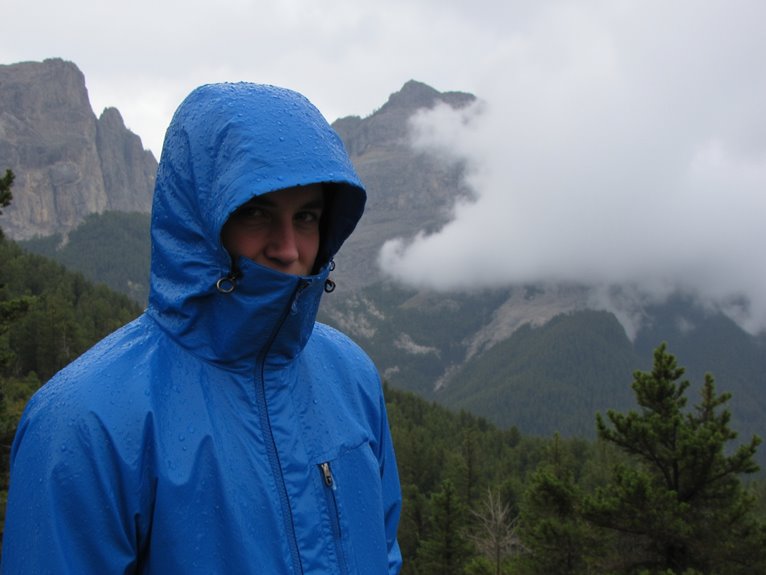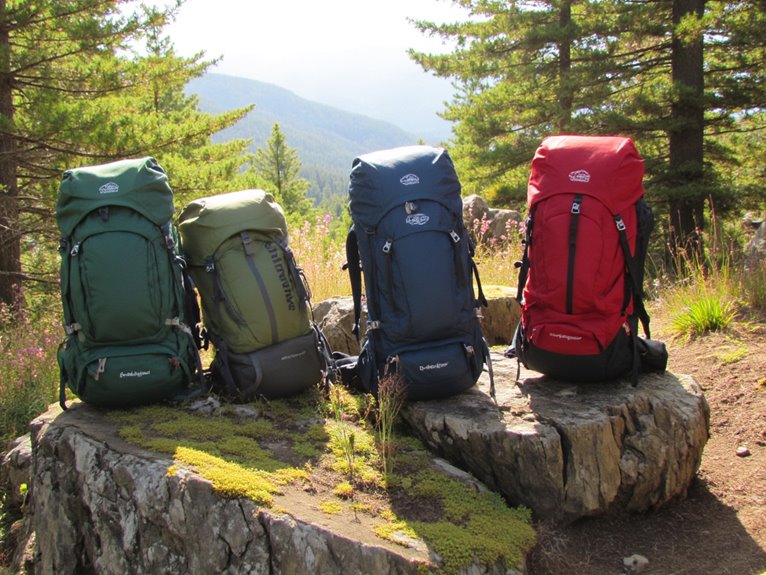How Cold Is Too Cold for a Tent?
Nylon and polyester tents can safely withstand temperatures as low as -20°C (-4°F), but cotton and canvas tents are more prone to freezing and should be avoided in extreme cold. However, wind chill factor, insulation, and snow load also play vital roles in determining a tent's performance in cold weather. Understanding these factors is essential for a safe and comfortable camping experience. By considering these elements, campers can make informed decisions about their gear and preparations, ensuring a successful winter camping trip – and there's more to discover on how to prepare for the cold.
We are supported by our audience. When you purchase through links on our site, we may earn an affiliate commission, at no extra cost for you. Learn more. Last update on 1st January 2026 / Images from Amazon Product Advertising API.
Tent Materials and Temperature Limits
When selecting a tent for cold weather camping, it's crucial to think about the temperature limits of various materials, as some fabrics and constructions are more resilient to freezing temperatures than others.
Nylon and polyester tents, for instance, can withstand temperatures as low as -20°C (-4°F), while cotton and canvas tents are more prone to freezing and should be avoided in extreme cold.
Additionally, the type of waterproof coating and seam sealing used can also impact a tent's cold-weather performance.
Look for tents with a waterproof rating of at least 1,500mm and fully taped seams to guarantee protection from snow and ice.
Understanding Wind Chill Factor
In cold weather camping, wind chill factor plays a crucial role in determining the actual temperature felt by the camper, as it can make the air feel even colder than the thermometer reading.
Wind chill occurs when wind blows over exposed skin, causing heat loss and a perceived decrease in temperature.
The faster the wind speed, the greater the wind chill effect.
Campers should consider wind chill when planning their trip, as it can greatly impact their comfort and safety.
To calculate wind chill, campers can use online calculators or consult wind chill charts.
Effects of Cold on Tent Fabric
Cold temperatures can cause tent fabric to become brittle and prone to cracking, compromising the structural integrity of the tent.
As temperatures drop, the fabric's elasticity and flexibility decrease, making it more susceptible to damage from wind, snow, or accidental impacts.
This is particularly concerning for tents with silicone-coated nylon or polyester fabrics, which can become increasingly brittle in cold conditions.
If the fabric cracks or tears, water can seep in, rendering the tent useless.
To ensure optimal performance, choose a tent with cold-weather-resistant fabric and take precautions to minimize exposure to extreme cold.
Regular maintenance, such as cleaning and storing the tent properly, can also help mitigate the effects of cold on tent fabric.
Insulation and Sleeping Bag Ratings
When dealing with cold temperatures, effective insulation is essential for a comfortable and safe camping experience.
In this regard, understanding the various types of tent insulation, as well as sleeping bag ratings, is vital.
Tent Insulation Types
Three primary types of insulation are used in tents to retain warmth and comfort: reflective, radiant barrier, and thermal mass insulation.
Reflective insulation, often used in emergency blankets, works by reflecting body heat back to the camper.
Radiant barrier insulation, typically used in space blankets, reduces heat loss by reflecting radiant heat rather than absorbing it.
Thermal mass insulation, commonly used in foam pads, absorbs and releases heat slowly, providing a consistent temperature.
Each type of insulation has its strengths and weaknesses, and understanding their differences is essential in choosing the right tent for cold-weather camping.
Sleeping Bag Ratings
In the pursuit of a warm and comfortable night's sleep while camping in cold weather, understanding sleeping bag ratings is crucial, as they provide a standardized measure of a bag's ability to retain warmth. Sleeping bag ratings are typically measured in terms of temperature, with ratings such as 'comfort rating,' 'limit rating,' and 'extreme rating.' These ratings indicate the lowest temperature at which a person can expect to sleep comfortably, safely, and survive, respectively.
Three key factors to consider when evaluating sleeping bag ratings are:
Temperature ratings: Look for bags with EN (European Norm) or ISO (International Organization for Standardization) ratings, which ensure consistency and accuracy.
Fill power and material: Down-filled bags tend to be warmer and more compressible, while synthetic fills are more affordable and retain warmth when wet.
Moisture resistance: Consider bags with water-resistant treatments or membranes to prevent moisture from compromising the insulation.
Insulation R-Value
Beyond temperature ratings, the insulation R-value of a sleeping bag plays a significant role in determining its overall warmth and ability to retain heat.
This value measures the material's thermal resistance, with higher R-values indicating better insulation.
Sleeping bags are typically rated on a scale from R-1 (minimal insulation) to R-5 (extreme cold weather).
When choosing a sleeping bag, consider the R-value in conjunction with the temperature rating.
A higher R-value does not always translate to a warmer bag, as other factors like fill power and material quality also come into play.
Look for bags with a balanced R-value and temperature rating to guarantee a comfortable night's sleep in cold weather.
Tent Design and Snow Load
When venturing into snowy terrain, a tent's design plays a vital role in withstanding snow loads, as a well-engineered structure can mean the difference between a safe and comfortable shelter or a collapsed and potentially dangerous one.
A tent's design should prioritize snow load capacity, with features such as:
Steep roof angles: Allowing snow to slide off easily, reducing accumulation and weight.
Strong, sturdy poles: Capable of withstanding heavy snow loads and high winds.
Reinforced stitching and seams: Ensuring the tent's fabric can handle the stress of snow and wind.
Camping in Freezing Rain Conditions
When camping in freezing rain conditions, it is crucial to think about the dual threats of rain and wind, which can compromise tent stability and occupant safety.
Additionally, the frozen ground conditions can hinder secure anchoring, further exacerbating the risks.
Rain and Wind Effects
Freezing rain conditions can make camping a miserable experience, with rain and wind combining to penetrate even the most waterproof of tents.
The combination of freezing rain and wind can lead to a significant loss of heat, making it difficult to stay warm and dry inside the tent.
To mitigate the effects of rain and wind, consider the following:
- Choose a sheltered location: Look for natural windbreaks, such as trees or hills, to reduce wind exposure.
- Use a rain fly: A high-quality rain fly can provide an extra layer of protection against rain and wind.
- Seal any gaps: Verify that all tent seams and zippers are secured to prevent cold air and moisture from entering the tent.
Frozen Ground Conditions
Frozen ground conditions, characterized by a thick layer of ice and frozen soil, can transform a campsite into a hazardous and unforgiving environment.
The frozen terrain increases the risk of slipping and falling, and the rigid ground makes it difficult to secure tent stakes.
Additionally, the frozen soil can cause water to accumulate around the campsite, leading to wet and uncomfortable conditions.
To mitigate these risks, campers should bring crampons or traction devices to improve footing, use specialized tent stakes designed for frozen ground, and prioritize site selection to minimize water accumulation.
Hypothermia Risks in Cold Weather
Prolonged exposure to cold temperatures can cause hypothermia, a potentially life-threatening condition that occurs when the body's core temperature drops below 95°F (35°C).
When camping in cold weather, it's essential to recognize the signs of hypothermia to take prompt action.
The following factors increase the risk of hypothermia:
Wet clothing: Moisture greatly increases heat loss, making hypothermia more likely.
Wind chill: Strong winds can quickly lower body temperature, especially in wet conditions.
Physical exhaustion: Fatigue can impair the body's ability to regulate its temperature, making it more susceptible to hypothermia.
Winter Camping Gear Essentials
To guarantee a safe and comfortable winter camping experience, three essential gear items should always be included in your packing list:
A reliable sleeping bag should have a comfort rating that matches the expected low temperature.
A waterproof and breathable tent should be designed to withstand snow loads and high winds, while allowing moisture to escape.
A portable and efficient heating source, such as a portable stove or electric heater, can help maintain a comfortable temperature inside the tent.
Emergency Preparedness in Cold
Winter camping accidents can occur suddenly, and it is essential to be prepared for emergency situations, such as hypothermia, frostbite, and getting lost in the wilderness.
When venturing into the cold, it is crucial to be equipped with the necessary knowledge and gear to respond to emergencies effectively.
To ensure you're prepared, remember the following:
- Carry a first aid kit with supplies to treat cold-related injuries, such as hypothermia and frostbite.
- Pack a emergency shelter and warmth like a bivy sack, space blanket, and hand warmers.
- Bring a reliable means of communication like a satellite phone or a two-way radio to call for help in case of an emergency.




